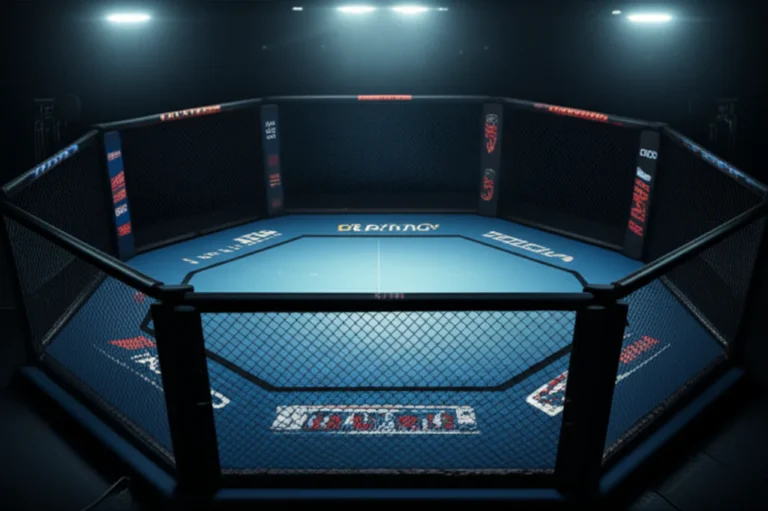Support our educational content for free when you purchase through links on our site. Learn more
What Type of Taekwondo Did Joe Rogan Do? 🥋 Discover the Secrets!
When you think of Joe Rogan, you might picture him as the charismatic UFC commentator or the host of one of the most popular podcasts in the world. But did you know that his martial arts journey began with Taekwondo? In this article, we’ll dive deep into the type of Taekwondo he practiced, how it shaped his career, and the incredible impact it had on his life. From winning championships to influencing his views on self-defense, Rogan’s Taekwondo background is a fascinating story that reveals much about his character and philosophy.
Have you ever wondered how a martial art can transform not just your body, but your entire outlook on life? Rogan’s experiences in Taekwondo might just hold the key! Join us as we explore the nuances of his training, the techniques he mastered, and the lessons he learned along the way.
Key Takeaways
- Joe Rogan practiced Traditional Taekwondo, specifically the Kukkiwon style, which emphasizes striking and forms.
- He became a US Open Champion and a full-contact state champion in Massachusetts, showcasing his skills at a young age.
- Rogan’s Taekwondo background significantly influenced his career in mixed martial arts and as a commentator, providing him with unique insights into striking techniques.
- His experiences highlight the transformative power of martial arts in building confidence and discipline.
Ready to kickstart your own martial arts journey? 👉 Shop Taekwondo gear on:
- Amazon: Taekwondo Gear
- Walmart: Taekwondo Equipment
- Century Martial Arts: Century Official Website
Table of Contents
- Quick Tips and Facts
- The Taekwondo Journey of Joe Rogan: A Deep Dive
- What Type of Taekwondo Did Joe Rogan Practice?
- Joe Rogan’s Early Life and Martial Arts Beginnings
- Career Highlights: From Taekwondo to MMA
- Joe Rogan’s Views on Martial Arts and Self-Defense
- Personal Life: How Taekwondo Influenced Joe Rogan
- Filmography: Joe Rogan’s Martial Arts Influence in Media
- Awards and Honors: Recognizing Joe Rogan’s Achievements
- The Impact of Taekwondo on Joe Rogan’s Career
- Training Regimen: How Joe Rogan Stays in Shape
- Conclusion
- Recommended Links
- FAQ
- Reference Links
Quick Tips and Facts
- Joe Rogan started practicing Taekwondo at age 15 and quickly excelled, winning the US Open Championship as a lightweight by age 19. 🥇
- He was a full-contact state champion in Massachusetts for four consecutive years.
- Rogan also dabbled in kickboxing, holding a 2-1 record before retiring from competition at 21 due to health concerns. ❌
- He has been an influential voice in the MMA community, often discussing the importance of martial arts in personal development. 💪
- Rogan’s Taekwondo background has significantly shaped his views on self-defense and mixed martial arts.
The Taekwondo Journey of Joe Rogan: A Deep Dive
Joe Rogan’s journey into the world of martial arts began in his teenage years, driven by a desire for confidence and self-improvement. He started with karate at age 14, but it was Taekwondo that truly captured his passion. As he himself said, “Martial arts gave me not just confidence, but also a different perspective of myself and what I was capable of.”
The Evolution of His Taekwondo Skills
Rogan’s dedication to Taekwondo led him to become a Taekwondo instructor and compete at high levels. His achievements in the sport laid the groundwork for his later success in MMA.
- Key Achievements:
- US Open Championship: Won at 19 years old.
- Massachusetts Full-Contact State Champion: Four consecutive years.
- Instructor: Transitioned from competitor to teacher, sharing his knowledge with others.
What Type of Taekwondo Did Joe Rogan Practice?
Rogan primarily practiced Traditional Taekwondo, which emphasizes both the art and the sport aspects of the discipline. He trained under the Kukkiwon style, which is recognized globally and is the official governing body of Taekwondo in South Korea.
Characteristics of Traditional Taekwondo
- Focus on Kicking Techniques: High, fast kicks and dynamic footwork.
- Forms (Hyung): A series of movements that simulate combat against imaginary opponents.
- Sparring (Gyeorugi): Controlled fighting that allows practitioners to apply techniques in a safe environment.
Comparison: Traditional Taekwondo vs. Other Styles
| Feature | Traditional Taekwondo | Olympic Taekwondo | MMA Taekwondo |
|---|---|---|---|
| Emphasis on Kicking | ✅ | ✅ | ✅ |
| Sparring Rules | Controlled | Full-contact | Full-contact |
| Focus on Forms | ✅ | Limited | ❌ |
| Self-Defense Techniques | ✅ | Limited | ✅ |
Joe Rogan’s Early Life and Martial Arts Beginnings
Rogan’s martial arts journey began as a response to his insecurities as a teenager. He sought to build confidence and physical prowess through martial arts.
Key Influences
- Fear of Being a “Loser”: This drove him to pursue martial arts.
- Mentorship: Early instructors played a crucial role in shaping his techniques and philosophy.
Career Highlights: From Taekwondo to MMA
Rogan’s transition from Taekwondo to mixed martial arts was seamless, thanks to his strong foundation in striking techniques.
Notable Career Milestones
- Kickboxing: Competed in amateur kickboxing, achieving a 2-1 record.
- UFC Commentator: Became a prominent voice in the UFC, sharing insights from his martial arts background.
- Podcast Host: Uses his platform to discuss martial arts, fitness, and self-improvement.
Joe Rogan’s Views on Martial Arts and Self-Defense
Rogan often emphasizes the importance of martial arts in personal development. He believes that training in disciplines like Taekwondo can significantly enhance self-confidence and physical fitness.
Key Perspectives
- Self-Defense: Advocates for practical self-defense training, integrating techniques from various martial arts.
- Mental Discipline: Highlights how martial arts foster mental resilience and focus.
Personal Life: How Taekwondo Influenced Joe Rogan
Rogan’s personal life is deeply intertwined with his martial arts journey. His experiences in Taekwondo have shaped his outlook on life, fitness, and health.
Impact on Lifestyle
- Fitness Regimen: Incorporates Taekwondo techniques into his daily workouts.
- Philosophy: Believes in continuous learning and improvement, a principle rooted in martial arts training.
Filmography: Joe Rogan’s Martial Arts Influence in Media
Rogan has appeared in various media, showcasing his martial arts skills and philosophy.
Notable Appearances
- “NewsRadio”: Played a character with martial arts skills.
- “The Joe Rogan Experience”: Regularly discusses martial arts with guests, influencing public perception of the sport.
Awards and Honors: Recognizing Joe Rogan’s Achievements
Rogan has received numerous accolades for his contributions to the martial arts and entertainment industries.
Highlights
- UFC Hall of Fame: Recognized for his role in promoting MMA.
- Podcast Awards: Multiple wins for his influential podcast.
The Impact of Taekwondo on Joe Rogan’s Career
Rogan’s Taekwondo background has been a cornerstone of his career, influencing his approach to both commentary and fitness.
Key Takeaways
- Striking Skills: His Taekwondo training enhances his understanding of striking in MMA.
- Philosophical Insights: His martial arts journey informs his discussions on discipline and mental strength.
Training Regimen: How Joe Rogan Stays in Shape
Rogan’s fitness routine is a blend of various martial arts, including Taekwondo.
Components of His Training
- Strength Training: Incorporates weightlifting and bodyweight exercises.
- Martial Arts Practice: Regularly practices Taekwondo and Brazilian Jiu-Jitsu.
- Cardio: Engages in high-intensity interval training (HIIT) for endurance.
Sample Weekly Routine
| Day | Activity |
|---|---|
| Monday | Taekwondo + Strength Training |
| Tuesday | BJJ + Cardio |
| Wednesday | Taekwondo + HIIT |
| Thursday | Rest |
| Friday | Kickboxing + Strength Training |
| Saturday | Taekwondo + Cardio |
| Sunday | Rest or Light Activity |
Conclusion
![Brisbane LTD buffet car - diner Title: Brisbane LTD buffet car - diner Dated: 06/11/1963 Digital ID: NRS21573_2_PR005511_c Series: NRS 21573 Glass plate and acetate negatives with ‘PR’ [Public Relations] prefix [State Rail] Rights: No known copyright restrictions www.records.nsw.gov.au/about-us/rights-and-permissions We'd love to hear from you if you use our photos/documents. Many other photos in our collection are available to view and browse on our website. by MMA Ninja a black and white photo of a group of people eating](https://www.mma-ninja.com/wp-content/uploads/sites/8/2025/04/photo-1676906242804-79616edb32d0cropentropycstinysrgbfitmaxfmjpgixidM3w0NDMxOTh8MHwxfHNlYXJjaHw2fHxqb2UlMjByb2dhbiUyMGluJTIwdGFla3dvbmRvJTIwdW5pZm9ybXxlbnwwfHx8fDE3NDQyNDAzODB8MAixlibrb-4.0.jpg)
Joe Rogan’s journey through Taekwondo has not only shaped his career but also his philosophy on life and fitness. His experiences highlight the transformative power of martial arts, making him a compelling figure in both the MMA community and popular culture. If you’re looking to enhance your own martial arts journey, consider exploring the principles Rogan advocates—confidence, discipline, and continuous learning.
Recommended Links
- The Best MMA Fighting Style: Unleash Your Inner Warrior! 2024
- Fighter Profiles
- MMA History
- Mixed Martial Arts Philosophy
- MMA Industry News
- MMA Rules and Regulations
FAQ

What age did Joe Rogan start Taekwondo?
Rogan began practicing Taekwondo at age 15.
What championships did Joe Rogan win?
He won the US Open Championship in Taekwondo and was a full-contact state champion in Massachusetts.
How has Taekwondo influenced Joe Rogan’s career?
His Taekwondo background has shaped his understanding of striking and self-defense, significantly impacting his commentary in MMA.
Reference Links
Conclusion

In summary, Joe Rogan’s journey through Taekwondo has been a pivotal aspect of his life, shaping not only his physical abilities but also his mental outlook and career trajectory. His achievements in Taekwondo, including winning the US Open Championship and becoming a full-contact state champion, laid a strong foundation for his later success in mixed martial arts and as a commentator.
Positives:
- Confidence and Discipline: Rogan credits martial arts with providing him confidence and a new perspective on his capabilities.
- Skill Development: His Taekwondo training has significantly enhanced his striking skills, which he effectively utilizes in his commentary and discussions on MMA.
- Influence on Fitness: Rogan’s commitment to martial arts has led to a lifelong dedication to fitness and health.
Negatives:
- Injury Risks: Like many martial arts, Taekwondo can lead to injuries, which Rogan experienced firsthand, retiring from competition at a young age due to health concerns.
- Limited Self-Defense Focus: While Taekwondo is excellent for striking, it may not cover all aspects of self-defense, particularly ground fighting, which is crucial in real-world scenarios.
Overall, we confidently recommend exploring Taekwondo as a martial art, whether you’re looking to build confidence, improve fitness, or simply learn a new skill. Rogan’s journey exemplifies the transformative power of martial arts, making it a worthwhile pursuit for anyone interested in personal development.
Recommended Links
-
👉 Shop Taekwondo Gear on:
- Amazon: Taekwondo Gear
- Walmart: Taekwondo Equipment
- Century Martial Arts: Century Official Website
-
Books on Martial Arts:
FAQ

What style of martial arts does Joe Rogan practice besides Taekwondo?
Brazilian Jiu-Jitsu (BJJ)
Joe Rogan is also a practitioner of Brazilian Jiu-Jitsu, having earned a black belt under Eddie Bravo. BJJ focuses on ground fighting and submission grappling, complementing Rogan’s striking skills from Taekwondo. This combination allows him to have a well-rounded understanding of mixed martial arts.
How did Joe Rogan’s Taekwondo background influence his career in mixed martial arts commentary?
Enhanced Understanding of Striking
Rogan’s Taekwondo training has provided him with a deep understanding of striking techniques, which he effectively communicates during UFC broadcasts. His firsthand experience allows him to analyze fights with a unique perspective, making his commentary insightful and engaging for viewers.
What is the difference between Taekwondo and other martial arts disciplines in terms of effectiveness in real-world self-defense scenarios?
Focus on Striking vs. Grappling
Taekwondo primarily emphasizes striking techniques, particularly kicks, which can be effective in stand-up confrontations. However, it may lack comprehensive ground-fighting techniques found in disciplines like Brazilian Jiu-Jitsu or wrestling. In real-world self-defense, a mixed approach that includes grappling skills is often more effective.
Can training in Taekwondo provide a solid foundation for transitioning to other mixed martial arts disciplines like Brazilian jiu-jitsu or boxing?
Yes, Absolutely!
Training in Taekwondo can provide a solid foundation for transitioning to other martial arts. The agility, balance, and footwork developed in Taekwondo are beneficial in boxing and BJJ. Many fighters find that their striking skills enhance their overall performance in MMA, making Taekwondo a valuable starting point.
What are some common misconceptions about Taekwondo?
Misconceptions about Effectiveness
One common misconception is that Taekwondo is not practical for self-defense. While it focuses on sport and competition, the techniques learned can be adapted for self-defense situations. Additionally, some believe that Taekwondo lacks real-world applicability, but many successful fighters have proven otherwise.
How can I get started with Taekwondo training?
Finding a Local Dojo
To get started with Taekwondo, look for a local dojo or martial arts school that offers classes. Many schools provide introductory sessions, allowing you to experience the training environment before committing. Additionally, consider joining online communities to connect with other practitioners and gain insights.
Read more about “How to Start Training in Mixed Martial Arts: 10 Essential Tips! 🥋”




